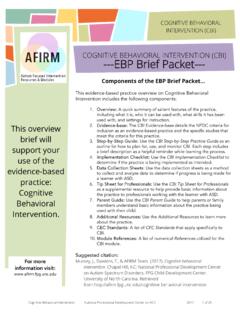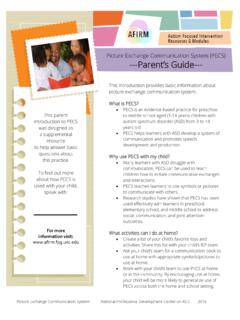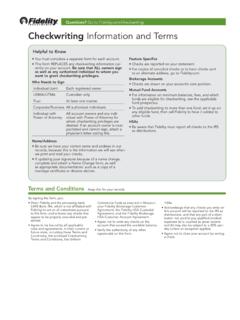Transcription of ---Step-by-Step Guide---
1 Picture Exchange Communication System National Professional Development Center on ASD 2016 1 This practice guide outlines how to plan for, use, and monitor the Picture Exchange Communication System practice. Keep in mind that PECS teacher the learner to use visual-graphic symbols to communicate with others. BEFORE YOU Each of the following points is important to address so that you can be sure the selected EBP is likely to address the learning needs of your student. Have you found out more information about..? Identified the Collected baseline data through direct Established a goal or outcome that clearly states when the behavior will occur, what the target skill is, and how the team will know when the skill is If the answer to any of these is no, review the process of how to select an EBP.
2 For more information visit: Picture Exchange Communication System (PECS) ---Step-by-Step Guide--- Picture Exchange Communication System National Professional Development Center on ASD 2016 2 Now you are ready to Step 1: PECS Planning The planning step how to conduct a reinforcer sampling and prepare materials for PECS. Receive PECS training from a certified PECS Training This module is not intended to take the place of training provided by Pyramid Educational Consultants, Inc. For information on training and resources provided, visit the Pyramid Educational Consultants, Inc. website at Establish performance criteria for program goals A minimum of two adults are needed to implement PECS.
3 One adult is identified as the helper and the other adult as the communicative partner . Conduct a reinforcer sampling Reinforcers are needed for using PECS. A reinforcer sampling can be used to identify reinforcers for individual learner. The PECS Reinforcer Sampling found in the Resource section will help you identify potential reinforcers to use with the learner. Conduct assessments Determine the learner s current communication skills. The information collected through assessments, will help team members determine target skills for PECS training (for example, requesting, initiating interactions) and types of prompts that can be used to facilitate communicative exchanges. Prepare communication pictures/symbols and books No specific pictures or symbols are required for PECS.
4 Select the pictures/symbols that are the easiest to create and use. A designated communication book is needed to store all commonly used pictures/symbols. Plan for creating at least two copies of the communication book for use when the learner begins using PECS across settings and with different communicative partners. Picture Exchange Communication System National Professional Development Center on ASD 2016 3 Step 2: Using PECS This section describes the process of using PECS and each phase of instruction. Implement Phase 1: Teaching the physically assisted exchange The goal of Phase 1 is for the learner with ASD to look at, reach for, pick up, and hand the picture/symbol to the communicative partner.
5 To accomplish this goal, address the following: Arrange the training environment by creating opportunities for learning should be available in both a structured and unstructured environment. In a structured training environment, the learner with ASD should be across from the communicative partner, with a helper seated behind or beside the learner to assist in developing the desired actions. To help learners generalize the use of newly acquired skills across settings, activities, and people, PECS training can occur in unstructured environments such as during center time, recess, or lunch. Helper physically prompts the learner s communicative exchange with communicative partner. During this stage, no verbal prompts are used with the learner to increase the learner s independence and reduce the learner s reliance upon others during communicative exchanges.
6 Reward learner with reinforcer (desired item) once the learner gives the picture/symbol to the communicative partner AND the communicative partner labels the item. Gradually reduce the amount of assistance so that few or no prompts are needed for the learner to initiate and complete an exchange by using backward chaining. As the learner becomes more independent during communicative exchanges and less physical assistance from the helper is required, the communicative partner can begin to fade the open-hand prompt. The learner meets basic skills of Phase 1 and is ready to move to Phase 2 when the learner is: o Reaching for the high-interest item o Picking up the picture/symbol of the item, o Handing the picture/symbol to the communicative partner o Acquiring high interest item Implement Phase 2: Expanding spontaneity The goal of Phase 2 is for the learner with ASD to increase spontaneity and generalization of the picture exchange.
7 To accomplish this goal, address the following: Increase the number and variety of reinforcer items to prevent satiation. The learner with ASD should exchange pictures/symbols with more communicative partners selected from individuals with whom the learner interacts on a regular basis. To increase generalization of the communicative exchange, instruction should occur in a variety of natural environments such as home, school, and community. The learner should seek out the communication book in order to request items from a partner. To expand the spontaneity of communicative exchanges, use the following two traveling activities: 1) increase the distance to the communicative partner and 2) increase the distance from the communication book.
8 The learner meets skills of Phase 2 and is ready to move to Phase 3 when the learner is: o Traveling to communicative partner (distance) o Traveling to communication book (distance). Picture Exchange Communication System STEP-BY-STEP Picture Exchange Communication System National Professional Development Center on ASD 2016 4 Picture Exchange Communication System STEP-BY-STEP Step 2: Using PECS (continued) Implement Phase 3: Simultaneous discrimination of pictures The goal of Phase 3 is for the learner to attend to the pictures/symbols in order to discriminate between them. To accomplish this goal, address the following: When beginning Phase 3, the communication book will only include two pictures/symbols.
9 One picture should be a known, highly reinforcing item or an item appropriate for the situation. The second picture is a non-preferred or unrelated item. It is very important to reinforce the learner s selection of the correct picture as soon as it happens. If learners do not learn this skill as quickly, they will need specific instruction. For these learners, use the 4-step error correction procedure. Once the learner can discriminate between two pictures/symbols, additional pictures/symbols are introduced to allow for the learner to request from multiple picture/symbol options. Use correspondence checks to ensure that the learner is requesting and taking the item for which he or she is asking. The learner meets skills of Phase 3 and is ready to move to Phase 4 when the learner is: o Independently discriminating between 12 to 20 pictures/symbols o Accurately discriminating between 3 or pictures/symbols presented as options o Independently traveling to and from communication book to initiate exchange.
10 Implement Phase 4: Building sentence structure The goal of Phase 4 is for the learner to spontaneously make requests using simple sentence structure. To accomplish this goal, address the following: Introduce the sentence strip to the learner by placing the I want symbol on the left side of sentence strip, Communicative partner guides learner to place the selected picture/symbol next to I want symbol on sentence strip. After the learner removes the sentence strip (with assistance if needed) and hands it to the communicative partner, the communicative partner reads the sentence pointing to each symbol/picture. Use backward chaining to fade assistance. After the communicative partner reads, I want, and before naming the requested item, the communicative partner should pause to promote verbalization.














